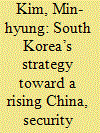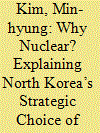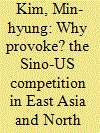|
|
|
Sort Order |
|
|
|
Items / Page
|
|
|
|
|
|
|
| Srl | Item |
| 1 |
ID:
159763


|
|
|
|
|
| Summary/Abstract |
This article presents an analysis of South Korea’s strategic choices over the Asian Infrastructure Investment Bank (AIIB), the Trans-Pacific Partnership (TPP), and the Terminal High Altitude Area Defense (THAAD) in light of the Sino–US competition in post-Cold War East Asia. South Korea’s puzzling behavior here represents Seoul’s hedging strategy against the uncertain future of the Sino–US competition in East Asia. The driving force of South Korea’s hedging behavior is Seoul’s dual concerns about being excessively dependent on the USA for its security at the time of China’s rapid rise on the one hand and being pulled into a growing China’s sphere of influence at the expense of traditional US–ROK security ties on the other. Reflecting Seoul’s prudent balancing acts between the two superpowers, South Korea’s hedging often results in apparently indecisive and underdetermined strategic choices in the face of the intensifying Sino–US competition. Nevertheless, South Korea’s hedging strategy allows Seoul to deepen extensive economic ties with Beijing while maintaining a traditional security alliance with Washington. The hedging behavior of South Korea, which is uniquely positioned as a strategic partner of rapidly rising China as well as a key security ally of the rebalancing USA, sheds important light on the behavior of middle powers in alliance politics, which has largely been neglected in the current literature.
|
|
|
|
|
|
|
|
|
|
|
|
|
|
|
|
| 2 |
ID:
163107


|
|
|
|
|
| Summary/Abstract |
This article seeks to critically assess the relevance of International Relations Theory (IRT) for East Asia International Relations (IR). After identifying the shortcomings of IRT in explaining East Asia IR, the article provides several ways to modify it with a goal to make it more suitable for East Asia IR. Its central claim is that the IRT’s bias toward European experiences and great power politics generates unsatisfactory accounts for and inaccurate predictions about East Asia IR. This does not mean, however, that we should treat IRT as completely irrelevant and develop an indigenous theory of East Asia IR. Given that no single theory is complete and perfectly relevant across time and space and that many core concepts and key variables of IRT are also pertinent for East Asia IR, our efforts should instead be made to refine the existing IRT and make it more suitable for East Asia IR by problematising its major assumptions and central claims on the basis of East Asian experiences. This will save IRT from being a region-specific and a country-specific theory of IR.
|
|
|
|
|
|
|
|
|
|
|
|
|
|
|
|
| 3 |
ID:
166009


|
|
|
|
|
| Summary/Abstract |
The main goal of this article is to explain the American failure of deterring North Korean nuclear proliferation. Specically, it examines the underlying reasons for which U.S. inhibition policy toward North Korea has failed, despite the numerous attempts by U.S. administrations (both Republicans and Democrats) to prevent North Korea’s nuclear development. The central thesis of the article is that while there were multiple reasons for the American failure of North Korean proliferation, the most important ones were U.S. misperceptions about both North Korea’s and China’s intentions and U.S. distraction by the war on terror. These factors, along with Pyongyang’s shrewd strategies to manipulate Washington, Seoul, and Beijing, played a key role in the emergence of a nuclear North Korea.
|
|
|
|
|
|
|
|
|
|
|
|
|
|
|
|
| 4 |
ID:
192153


|
|
|
|
|
| Summary/Abstract |
A nuclear armed-state enjoys enormous benefits in world politics including near-absolute security, security policymaking autonomy and independence, heightened international bargaining power, and a high probability of emerging victorious in disputes with non-nuclear states.Footnote1 Given the abundant benefits, it is understandable that non-nuclear states would desire to become nuclear. In particular, when a state is threatened by an enemy armed with nuclear weapons, the desire to be similarly nuclear-armed for the sake of its own survival increases substantially.
|
|
|
|
|
|
|
|
|
|
|
|
|
|
|
|
| 5 |
ID:
146903


|
|
|
|
|
| Summary/Abstract |
This article contends that South Korea’s behaviors toward China since 1992 can be fully understood when the structural variables of the strategic environment—i.e., economic interdependence, the US-centered hub-and-spoke system, and the North Korean threat—are combined with the domestic variable of Seoul’s leadership change and its perception of threat.
|
|
|
|
|
|
|
|
|
|
|
|
|
|
|
|
| 6 |
ID:
145785


|
|
|
|
|
| Summary/Abstract |
This article seeks to explain through the contextualized comparisons of a few critical cases how national preferences on an interstate bargaining issue are formed domestically. It proposes an interaction framework of national preference formation (NPF), which emphasizes the government's policy autonomy, the size of the ruling party or coalition, and the party unity in aggregating divergent domestic preferences for interstate bargaining. The framework is tested against major European Community members' preference formation on Economic and Monetary Union (EMU). Case studies reveal that the interaction framework quite accurately describes the national preferences of Germany, Britain, and France over EMU.
|
|
|
|
|
|
|
|
|
|
|
|
|
|
|
|
| 7 |
ID:
170511


|
|
|
|
|
| Summary/Abstract |
The main purpose of this article is to critically examine the EU’s policies toward North Korea’s weapons of mass destruction (WMD) programs. By analyzing the EU’s approach to North Korea’s nuclear and ballistic missile programs, this article contributes to the debate about what kind of an actor the EU really is—i.e., whether it is a military power, a civilian power, or a normative power—in the security arena of world politics. As an autocratic regime with fundamental problems in relation to the proliferation of WMD and human rights, North Korea presents a good test case for considering the contested concept of EU’s international identity. The central thesis explored in the present article is that the EU is, strictly speaking, neither a military, nor a civilian, nor a normative power. That said, the EU’s international identity is closest to the concept of a global civilian power.
|
|
|
|
|
|
|
|
|
|
|
|
|
|
|
|
| 8 |
ID:
182460


|
|
|
|
|
| Summary/Abstract |
This article seeks to provide a theoretically compelling account for North Korea’s strategic choice to go nuclear and explores its implications for East Asian security. Its main research question is as follows: despite the obvious risks of going nuclear, what makes North Korea so desperate in its pursuit of nuclear capabilities? Contrary to the extant accounts that only emphasize either nonsecurity variables or an “external security” factor, this article conceptualizes North Korea’s security considerations as “regime survival” and explains its strategic choice from it. The central thesis of this article is that North Korea’s decision to go nuclear is a strategic choice, of which the purpose is to achieve its goals of safeguarding independence from external powers as well as ensuring regime security. North Korea pursues nuclear weapons because they not only protect Pyongyang’s regime from foreign aggressions but also help to consolidate Kim Jong-un’s domestic power. North Korea also seeks nuclear weapons in order to safeguard its independence and autonomy from China because the removal of China’s influence is critical to ensuring its regime survival in the long run. North Korea’s strategic choice to go nuclear and its emergence as a de facto nuclear power have significant implications for East Asian security.
|
|
|
|
|
|
|
|
|
|
|
|
|
|
|
|
| 9 |
ID:
149017


|
|
|
|
|
| Summary/Abstract |
This article seeks to make sense of North Korean provocations in light of the Sino-US strategic competition in post-Cold War East Asia, where such variables as China’s rise, US’s pivot to Asia, and growing Sino-ROK economic ties are driving the strategic choices of major states in the region. The article examines the main motivations behind Pyongyang’s provocations since the end of the Cold War, discusses their implications for the Sino-US strategic competition in East Asia, and offers predictions about the future of North Korean provocations. The central thesis of the article is that Pyongyang has exploited the Sino-US strategic competition in East Asia for its regime survival. By raising North Korea’s strategic value to China, the intensifying Sino-US competition allows Pyongyang to continue provocations, regardless of Beijing’s explicit opposition.
|
|
|
|
|
|
|
|
|
|
|
|
|
|
|
|
|
|
|
|
|